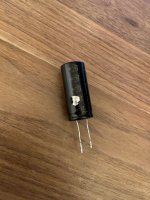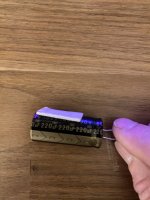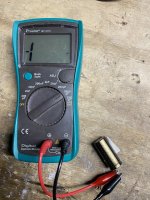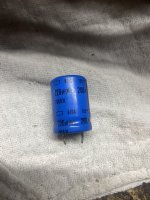Yes, that's fine. It's likely to be higher, usually.Should the 45 tube get up over 90 degrees Celsius?
Everything ok with the V7 filament regulators?
A couple updates. I ended up swapping the tubes and the issue with the tube getting hot stays in the left channel.
Radu emailed me separately and told me some resistance tests to check the coupling cathode capacitor on left channel.
Sure enough, the resistance checks pointed to the cap. I pulled the capacitor out and it had an obvious bulge on it and it tested bad on my meter.
My local electronic store has some brand new Nichicon HE caps. I’m going to see if they have a new pair on hand for 220uf 100V
I’ll keep everyone posted once I swap out the caps.
Radu emailed me separately and told me some resistance tests to check the coupling cathode capacitor on left channel.
Sure enough, the resistance checks pointed to the cap. I pulled the capacitor out and it had an obvious bulge on it and it tested bad on my meter.
My local electronic store has some brand new Nichicon HE caps. I’m going to see if they have a new pair on hand for 220uf 100V
I’ll keep everyone posted once I swap out the caps.
Attachments
Everything should be OK with your regulator. I've been using them for many years now and, regardless of the version and if put together properly, they perform excellent both electrically and sonically. Thank you Rod!Yes, that's fine. It's likely to be higher, usually.
Everything ok with the V7 filament regulators?
Sounds good. I’ll check these when I get home from work. I see the same issue on both tubes when I swap them. My friend has some spare 45s I can try if we confirm they are faulty.Without this capacitor the static function check can be performed (#20 post).
Radu thinks the low B+ voltage could be a result of more voltage being pulled by the bad cathode coupling cap.
Yes. The regulator on the problem channel had two resistors that didn’t match the working channel. Both now appear to work correctly after I swapped them out.
Today I stopped by my two electronic stores but neither of them had a 220uf 100V cap. After digging again through my caps I found some 220uf 200V snap ins and modified them just to put it into the location where the bad cap was. Resistance checks matched so I powered on the unit with the 100k resistors still between the grid and ground. Good news was neither tube started to overheat and both voltages mirrored each other.
The only thing I noticed was that both Anodes read either 215V or 220V. Could this mean I have two 45s that are bad? I can take them to my friends shop to test and swap out with another pair.
The only thing I noticed was that both Anodes read either 215V or 220V. Could this mean I have two 45s that are bad? I can take them to my friends shop to test and swap out with another pair.
Attachments
Let me check this again now that both sides are biasing correct and the left channel tube no longer gets hot after putting in a good 220uf cap.
I powered up the amp last night after wiring everything back and both tubes reached an even 62 degrees Celsius and the bias stayed right at 2.50VDC.
I even played some music on some cheap speakers and everything sounded good.
I powered up the amp last night after wiring everything back and both tubes reached an even 62 degrees Celsius and the bias stayed right at 2.50VDC.
I even played some music on some cheap speakers and everything sounded good.
- Home
- Amplifiers
- Tubes / Valves
- Shiny Eyes 45 Regulator Issues - Rod Coleman V7



